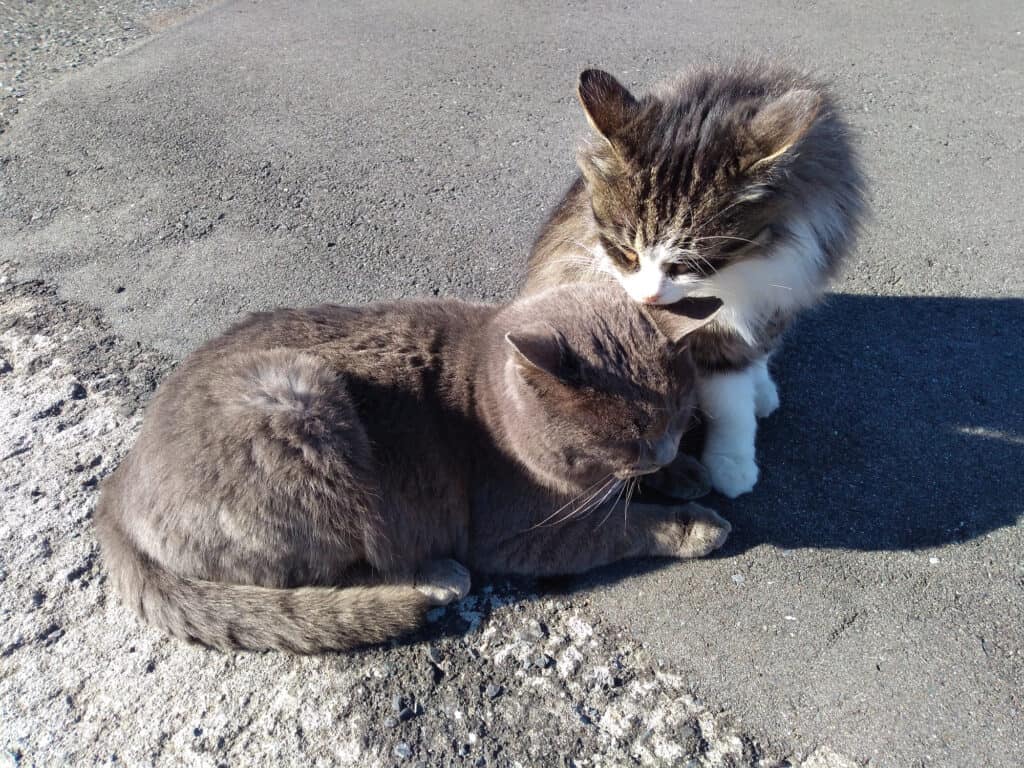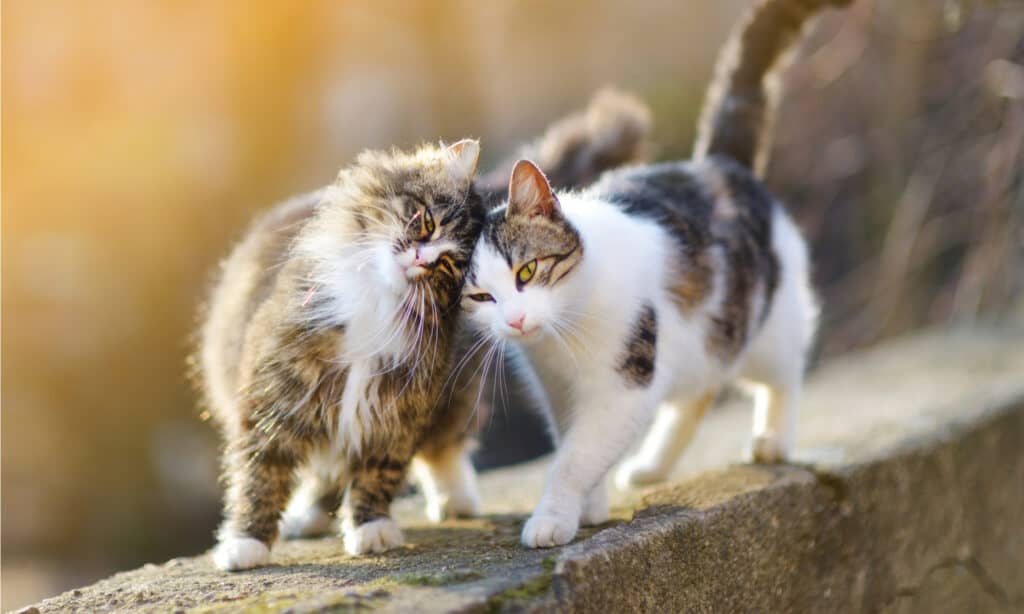You may have heard the term “feral cat”, but what does it actually mean? You’ve probably seen a feral cat sniffing around a dumpster or darting into the bushes. These misunderstood felines sometimes get a bad rap even though their situation is completely out of their control. As is so often the case in life, education is key. Let’s take a closer look at the different types of feral cats below.
What is a Feral Cat?
Feral cats are wild cats, in a way, and yet they are not entirely wild. They are still of the domesticated cat species (Felis catus), but they have been born in the wild and have had little contact with humans or negative interactions with humans. These cats are not owned by anyone and often form colonies.
In other words, a feral cat is actually just your common housecat but one that hasn’t had much contact with humans. They might be scared of people and resistant to contact, but they are not wild in the same way animals like bobcats and lynxes are. Feral cats lack the skills to survive in the wild, so they usually only live for 1-2 years.
Because of this, people often misunderstand feral cats and see them in a bad light. However, if they are spayed or neutered, feral cats can still live happily in a colony with a caretaker looking out for them.
Feral cats live almost anywhere, from urban areas to rural landscapes and farms. These cats do best in areas with access to food, water, and shelter — like abandoned buildings, undeveloped lots, alleyways, and even sewer systems. Feral cats in urban areas commonly scavenge food from garbage cans, and some may live near dumpsters. Most live in a colony with other cats. They’re usually fearful of or skittish around people; we’d see them more often if they weren’t such expert hiders.
The Different Types of Feral Cats

It’s possible but not super common for feral cats to be socialized.
©Juan_Algar/Shutterstock.com
- Total Feral: These cats have never experienced human touch or had only negative encounters with humans.
- Semi-Feral: Semi-feral cats are often shy or fearful around people but have still experienced some positive contact. Semi-feral cats usually have an easier time adjusting to being around people.
- Converted Feral: A converted feral cat is a former pet cat that was abandoned, left behind, or lost and has since acquired some semi-feral tendencies. They may be hesitant, shy, or skittish around humans due to their unfortunate experiences. However, converted ferals can become beloved companions with proper care and handling.
- Working Cat / Farm Cat / Barn Cat: Working cats are free-ranging, feral, or semi-feral domestic cats. They usually live outdoors in a barn or other shelter, and although sometimes fed by humans, they mainly survive on rodents. We call them “working” cats because they “work” by caring for pests and rodents where they live. Working cats help to keep crops, animals, and other areas clean and free from damage that mice and rats cause. You might also see working cats at outdoor cafes, convenience stores, churches, libraries, warehouses, and theme parks. Additionally, many animal rescues with working cats are available for adoption in these areas.
- Stray Cat: A stray cat is different than a feral cat. A stray cat is a domestic pet cat that has been abandoned, left behind, lost, or separated from its home. Stray cats have not yet developed semi-feral tendencies and often are friendly or shy with humans. Stray cats need love, care, and placement in a new home. With just a little help and nurturing, stray cats can usually become cherished pets and companions again.
Can Feral Cats Be Socialized?
It’s possible but not super common for feral cats to be socialized. These cats have lived in the wild with little to no human contact for most of their lives. It would take a great deal of time and patience to make it happen, and some feral cats never thoroughly socialize, no matter how hard you try. However, there are many cases when someone nursed a feral cat back to health, and, in the process, the cat developed a bond with and attachment to their caretaker.
Kittens born to feral cats, however, can be socialized! Kittens born to feral cats are no different than any other kitten born indoors to a loving family. Every kitten out there has the ability and potential to become socialized with people at a young age. However, if a kitten born to a feral cat does not have contact with humans (or has negative experiences with humans) before they are nine or 10 weeks old, it will most likely become a feral cat.
Community Cats and Cat Colonies
A colony is a group of community cats that lives in the same place. Community cats are free-roaming cats that live outdoors and do not have an owner. These cats can be feral or friendly, young or old, sick or healthy. If a cat lives outside but has an owner, it is not considered a community cat. However, community cats may have a dedicated caretaker who helps provide them with food, veterinary care, and spay or neuter services.
Unfortunately, many community cats end up in animal shelters. Feral cats are hard to adopt into homes because they are not socialized with humans. This leads to a very large number of cats being euthanized each year. Since many people see community cats as a nuisance, they persecute, hunt, injure, or kill outdoor cats.
The Vacuum Effect and Exponential Population Growth
For too many years, community cats of all kinds — but especially feral cats — have been rounded up and killed to control the population or get rid of them. However, other cats will move in and fill the void when they’re taken out of their environment. This is called the “vacuum effect.”
The problem is that the new cats that move in on the empty territory are not sterilized, so they begin to breed and reproduce exponentially, and the population quickly gets out of control. Many female cats can begin to reproduce as early as five months of age and can have two to three litters of one to eight kittens each year. That means that just a handful of cats could multiply into a colony with more than 300 cats in just one year!
Managed Colonies and TNR

TNR (Trap-Neuter-Return) helps control the feral cat population and ensures these cats are healthy and looked after.
©iStock.com/Nozomi Sato
A “managed colony” consists of cats with a human caretaker. Managed colonies are much healthier since the cats in these groups are given food and water, are provided with shelter from the weather, and have been spayed or neutered. The caretaker regularly checks up on the cats and helps to get them medical assistance when needed. This keeps the cats safer and healthier and avoids population increases since the cats cannot have more kittens.
One of the critical methods for managing cat colonies is TNR (Trap-Neuter-Return). TNR, also called TNVR (Trap-Neuter-Vaccinated-Return) or TNRM (Trap-Neuter-Return-Monitor), programs offer a humane way to manage cats that live outdoors without putting them in danger. It has been used all over the world with great success. People ask for permission from their local government, and once they get it, they can use this method to care for stray cats by trapping them, having them spayed or neutered, and then releasing them back into their colony. This helps control the feral cat population and ensures these cats are healthy and looked after.
Volunteers and animal rescue organizations run TNR programs worldwide, and many offer spay and neuter vouchers to help support needy areas. In addition, if they find a mother cat with babies, they bring the entire feline family into a foster home (if you find kittens and don’t know what to do, check out this guide from the ASPCA). The mother is spayed, all the cats are vaccinated, and the kittens are socialized and adopted into loving homes.
Ear-Tipping
A community cat that has been spayed or neutered is commonly returned to their original colony with an “ear-tip.” Ear-tipping is a way to identify which cats have been spayed or neutered. A veterinary professional removes the tip of one of the cat’s ears. This way, cat rescuers and veterinarians can ensure that cats that have already been sterilized (spayed or neutered) are not caught again and don’t have to undergo unnecessary surgery.
Occasionally you will see an ear-tipped cat available for adoption as well. Remember, a community cat is not always utterly feral, so often, a cat who has been spayed or neutered can be rescued and adopted into a loving home.
TNR programs help lower the number of cats that end up in shelters, create a long-term decrease in the number of cats that are outside, give cats protection by vaccinating them, use less taxpayer money since cats no longer have to be rounded up and killed, and make sure people and animals all get to live peacefully together.
How Does TNR Help Cats?

Feral cats and free-roaming cats hunt animals in the wild.
©MNStudio/Shutterstock.com
TNR helps stabilize the populations of community and feral cats by spaying and neutering, which means that these cats will have more food, more space, and less risk of disease. Community cats that have been exposed to TNR live healthier and safer lives. Spayed female cats have less risk of breast cancer or ovarian or uterine cancer. Neutered male cats do not get testicular cancer and are less likely to fight with other cats, leading to fewer injuries and infections.
How Does a Colony Manager or Caretaker Help Cats?
A colony manager or caretaker is someone who takes responsibility for the health and well-being of a feral cat colony by:
- Supplying food and water to community cats.
- Providing shelter.
- Humanely trapping the cats to take them to the vet for vaccinations and sterilization.
- Returning them to the same territory.
- Making many adoption and foster situations happen.
- Providing post-op care for spayed and neutered cats.
- Educating people in the neighborhood about feral cats and the colony.
- Working on socializing cats by interacting with them.
Why Do People Complain About Feral Cats?
Feral cats and free-roaming cats hunt animals in the wild, including songbirds, compete with other animals for food, and can spread disease. Since they do not have owners and rarely interact with humans, they often flee from people or become hostile toward them. In addition, unaltered community cats (cats that have not been neutered or spayed) fight a lot, especially when looking for mates, which causes a lot of loud noise. Unaltered male cats “spray” or urinate to mark territory. Here is a list of common complaints against feral cats:
- Noise, howling, and fighting
- Flea infestations
- Urinating or spraying
- Eating the food of domesticated animals
- Spreading disease
- Predation of birds and other wildlife
- Breeding
Most of the things people complain about are natural, inherent behaviors feral cats have. That is, they complain because feral cats are just being cats! The blame must fall squarely on the shoulders of humans who’ve domesticated them and left them unaltered to breed unfettered, which is why we must be part of the solution.
Final Thoughts
Many feral cats have one leg in the “pet world” and one in the wild. Cats have been domesticated, abandoned, and forgotten over and over again. Yet their population continues to grow.
We’ve created a situation that doesn’t look like it will get noticeably better soon. And the cats are blamed for simply being cats.
Hopefully, in the future, outreach will grow, and what’s in a community cat’s best interest will be paramount in the minds of everyone. They’re counting on us.
Up Next
Thank you for reading! Have some feedback for us? Contact the AZ Animals editorial team.








